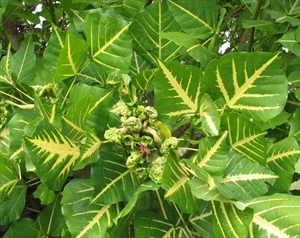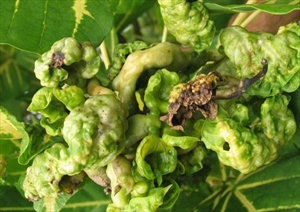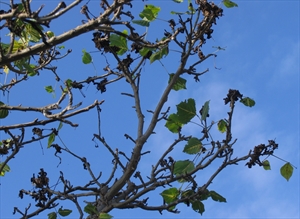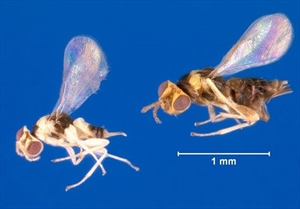Erythrina gall wasp
Pacific Pests, Pathogens and Weeds - Online edition
Pacific Pests, Pathogens & Weeds
Erythrina gall wasp (268)
Quadrastichus erythrinae
Asia, Africa, North and South America (restricted), the Caribbean (restricted), Oceania. It is reported from Fiji, Samoa, and Tonga. It is thought to be from East Africa originally.
Erythrina variegata, and other Erythrina species. There are more than 100 species worldwide in tropical and sub-tropical countries, and they are used as ornamentals, living fences, and also as shade trees for coffee and cocoa, especially as their roots form nitrogen-fixing nodules with Rhizobium bacteria.
The wasp lays its eggs in the youngest leaves and stems. As the larvae hatch they cause the galls to develop. The leaves become swollen and deformed, and look unlike the leaves of healthy trees (Photos 1&2). Repeated attacks cause dieback and death (Photo 3).
The larvae pupate in the swollen tissues, and the adults cut holes in the leaves and stems to emerge (Photo 4). The wasps are 1-1.5 mm in length, with the female being larger than the male (Photo 5). The life cycle is about 20 days.
Spread over short distances is by flight, on the wind, and perhaps on clothing. Spread over long distances is thought to be on fallen leaves perhaps on boats or planes.
The damage is severe. Trees are defoliated by the gall wasp and often die as cycles of regrowth and attack result in loss of reserves. Erythrina seedlings are killed by infestations and this threatens stands of the tree. For example, in Hawaii about 95% of the Erythrina sandwicensis (wiliwili tree) and Erythrina variegata - important trees in the endangered lowland dry forest - have been killed by the gall wasp.
Look for the mass of distorted swollen shoots on Erythrina trees, and seedlings, and trees that show die back.
BIOSECURITY
Boats carrying fallen infested leaves have been suggested as a pathway for spreading Erythrina gall wasp.
Quadrastichus erythrinae is on the Global Invasive Species Database (2021) of information on alien and invasive species that negatively impact biodiversity, managed by the Invasive Species Specialist Group of the IUCN Species Survival Commission: http://www.iucngisd.org/gisd/species.php?sc=965.
NATURAL ENEMIES
After extensive search for parastioids in Africa and testing, scientists in Hawaii selected Eurytoma erythrinae to have the potential to bring the gall wasp outbreaks under control. Tests showed that it was a specific parasitoid of the gall wasp. Releases began in 2008, and have shown a substantial decrease in gall wasp populations. Importantly, Erythrina trees recovered with the production of healthy leaves and full canopies, although flowers of Erythrina sandwicensis still show damage. The release of another biocontrol agent, Aprostocetus nitens, an ectoparasitoid, is being considered.
CULTURAL CONTROL
No control measures are recommended. Pruning has been tried, but was not successful. It is important, however, not to move Erythrina plants between localities where the gall wasp is present and where it has not yet established.
CHEMICAL CONTROL
Injection of imidacloprid has been trialed, and is only recommended for highly valued ornamental trees because of the cost of this method.
____________________
When using a pesticide, always wear protective clothing and follow the instructions on the product label, such as dosage, timing of application, and pre-harvest interval. Recommendations will vary with the crop and system of cultivation. Expert advice on the most appropriate pesticide to use should always be sought from local agricultural authorities.
AUTHOR Grahame Jackson
Information from Heu RA, et al. (2008) Erythrina erythrinae Kim (Hymenoptera: Eulophidae). New Pest Advisory. No. 05-03. State of Hawaii, Department of Agriculture; and from CABI (2015) Quadrastichus erythrinae (Erythrina gall wasp). Crop Protection Compendium (https://www.cabi.org/cpc/restricted/?target=%2fcpc%2fdatasheet%2f46220); and from Hawaii Invasive Species Council (2019) Invasive species: Erythrina gall wasp (Quadrastichus erythrinae). (https://dlnr.hawaii.gov/hisc/info/biocontrol/latest-biocontrol/erythrina-gall-wasp/). Photos 1&2 Albert (Bud) Mayfield, USDA Forest Service, Bugwood.org. Photo 3 Albert (Bud) Mayfield, USDA Forest Service, Bugwood.org. Photo 4 Richard Markham, ACIAR, Canberra. Photo 5 Erich G. Vallery, USDA Forest Service - SRS-4552, Bugwood.org.
Produced with support from the Australian Centre for International Agricultural Research under project PC/2010/090: Strengthening integrated crop management research in the Pacific Islands in support of sustainable intensification of high-value crop production, implemented by the University of Queensland and the Secretariat of the Pacific Community.








